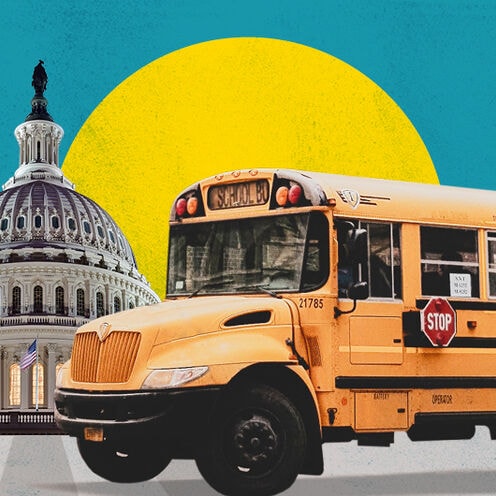
The Future of Education Under the Biden Administration
Educational equity policy experts discuss the Biden administration’s proposed education policies and their hopes for the future of education in America.
Education is one of the most urgent priorities for the first 100 days of the Biden administration and beyond.
This is the second article of a two-part series on how President Joe Biden’s team planned its approach to education policy and the future of education under his administration. Part one, "How the Biden Team Is Planning Its Pivot on Education," was published Jan. 15.
Some of President Joe Biden’s proposed education policies include safely reopening schools as quickly as possible, investing in early childhood education, eliminating the funding gap between affluent and low-income school districts, and increasing teacher pay. But how will the administration overcome the formidable obstacles of the coronavirus pandemic, economic recession, and deep political division to achieve those goals?
We spoke with four educational equity policy experts to learn more about the president’s top education policy priorities and how they would impact low-income students. Together, they tackle the question: What could the future of education look like with a renewed focus on marginalized students under the Biden administration, and what will it take to get there?

- Bijan Verlin (Greater Philadelphia ‘14), former education policy fellow for the office of Senator Brian Schatz in Washington, D.C.
- Michael Rady (New Jersey ‘13), former education policy fellow for Senator Cory Booker and former field organizer for the Amy McGrath for Senate campaign in Bowling Green, Kentucky
- Rebecca Planchard (Dallas - Fort Worth ‘11), senior early childhood policy advisor for the North Carolina Department of Health and Human Services
- Reginald White (Memphis ‘17), external relations manager at The Education Trust and former policy fellow for House Democratic Caucus Chairman Hakeem Jeffries in Washington, D.C.
Public schools are in a deep funding crisis. What steps can the Biden administration take to ensure they get the funding needed to support students during this pandemic and beyond?
Rady: The most immediate step for the Biden administration to take is to make sure that the $60 billion toward education that was allocated in the most recent COVID relief package is quickly allocated to states and districts and institutions of higher education. This is four times the amount of money that was appropriated via the CARES Act. Getting money out the door and making sure that it's going where it needs to go—that means where it's needed the most—is absolutely critical for the new administration.
On top of that, we saw that there wasn't state and local relief included in this most recent package. What that means is state and local governments are seeing this huge looming budget crisis, which will disproportionately impact school districts in low-income communities—school districts serving predominantly Black and brown students. President Biden has talked about COVID-19 response and relief being his No. 1 priority at the start of his administration, and this most recently passed package is a down payment toward additional relief.
The Biden administration will need to usher through Congress substantial additional relief to schools and state and local governments, so they are not forced to fire teachers, counselors, and other personnel who are essential to helping kids overcome the widespread trauma and learning loss brought on by the pandemic.
What should the Biden administration do to address the digital divide, which is disproportionately harming the learning of low-income students and students of color?
Verlin: This is a resource and logistics issue. There is bipartisan consensus from rural schools, schools on native lands, schools on tribal lands, and urban schools on how the Biden administration can and should use federal dollars to help put devices in the hands of students. The issue of broadband access is trickier because it's an issue of infrastructure. However, it will almost certainly be part of any large scale infrastructure package, which seems inevitable considering “Build Back Better."
White: We know that focusing resources on access to technology is not enough, but access to internet connectivity, computers, and other modern learning tools is a necessary element in achieving educational equity. With my experience attending rural schools in Virginia and teaching kindergarten in Memphis, Tennessee, I witnessed the disheartening outcomes resulting from a lack of adequate technology and broadband access needed for high-impact instruction. Making additional, substantive investments in improving and expanding our country’s high-speed broadband infrastructure is critical to closing preexisting gaps in K-12 access to learning that have only been exacerbated by the COVID-19 pandemic. A key component of this effort, in partnership with the newly-shifted Congress, is ensuring that the Biden administration works to bolster the FCC’s E-Rate program, which is central to providing internet connectivity and technology to millions of students across the country. Modernizing the program to not only meet the current moment, but also proactively establishing safeguards and standing up supports that target our nation’s most historically underserved communities that feel the impact of the digital divide the most, is essential.
The Biden administration has stated its goal of doubling the number of psychologists, counselors, nurses, and social workers in schools. How would this investment help students, particularly those who are coping with the trauma of the COVID-19 pandemic?
Planchard: What we see over and over again, in different types of studies, is that when children have experienced trauma, having really strong connections to stable adults in their lives is essential. That can be game changing for a child to have a different educational trajectory and a different life trajectory.
In North Carolina, we know that we do not have enough school nurses, we do not have enough social workers—not even close to the national ratios of what's recommended for nurses to students and social workers to students—to provide the supports our students desperately need. Having that support is essential.
But we cannot expect our children to be well if the adults caring for them are not well. I love that the administration is getting clear about the investment needed in staffing supports for kids. I also would be interested in hearing what we are doing to support the mental health services that our educators need

How the Biden Administration Prepared for This Moment. Learn how the Biden education team handled multiple national crises leading up to the inauguration as it planned its pivot on the past four years of education.
The Biden transition team announced plans to reinstate Obama-era guidance on school discipline. What might this look like?
Rady: This is an absolutely essential action for the Biden administration to take immediately. We know that Black girls are four times as likely to be arrested in school than white girls. There are just so many videos that have come out over the previous few years of SROs—school resource officers—and other school police using violence against Black and brown students.
I am a queer person, and I do a lot of advocacy in the LGBTQ+ education inclusivity space with organizations like GLSEN. We also know that LGBTQ students, especially LGBTQ students of color, are disproportionately impacted by discipline as well. They're disproportionately suspended, for example. This disparate impact guidance that came out from the Obama administration in 2014 is something that can be restored on Day One, without having to go through the regulatory process, and it will be a game changer for students.
The Biden administration intends to double the Pell Grant to help low-income students afford college. What else does the Biden administration plan to do to make college more affordable for low-income students?
Verlin: One thing that I know the Biden administration is interested in, and I think you'll see a lot of Dr. Jill Biden being part of this conversation, is community college. There's a lot of space, time, and energy that will and can be devoted to making community colleges more effective for low-income students. I know the Biden administration is interested in making the two-year programs free or making two years of community college free.
When it comes to helping low-income students, theoretically, a community college could be a great option. It can be really affordable, it's close to home if you have to work or if you have kids to take care of. Community college is a great thing.
White: Expanded student loan forgiveness stands out as a measure that would have a profound impact on the ability of low-income students to accumulate wealth and increase their economic mobility for generations to come. So many Americans, especially in communities of color and those from under-resourced communities, are crippled by their student loan debt payments and inhibits their ability to pursue a broad range of opportunities.
As a first step, the administration can help hundreds of thousands of students, many of them from low-income backgrounds and/or students of color, by unobstructing their borrower defense claims and forgiving the debt they hold from predatory for-profit colleges that misled and defrauded them. Even broader debt forgiveness would empower millions to more freely explore and achieve their personal, professional, and financial goals and, in turn, narrow the persistent racial wealth gap we see across our country. These policies must also be linked to increased federal investment in public higher education systems to create pathways to debt-free college, including doubling the Pell Grant, for students from low-income backgrounds and students of color, and the administration should join with Congress in making that a reality.
What other policies would you like to see the Biden administration pursue that would help students from low-income communities?
Verlin: One of the Biden campaign plans is really doubling down on funding community schools from the federal government. The community schools program is about $40 million a year, which is small potatoes when it comes to federal spending.
A community school is a school with wraparound services. There also can be social workers to help connect people to benefits. There is a huge range of what it can look like. For example, LeBron James has opened a community school that's doing extremely well.
Another big piece is that it also does a lot to treat the school as the center of the community. Whether that's hosting polling stations, whether that's providing adult literacy classes or hosting community college courses—all of those things add up to make a school more of a bedrock for the community. In places that are sometimes food deserts, a central location for food drop-offs or farmers' markets can make a big difference. When we're thinking about providing resources to the neediest, the most at-risk students, that is one way to shift resources.
Planchard: I would love to see a federal reimagining of in-person education during the COVID-19 pandemic rather than all 50 states hustling and figuring out what we can do. I want to see alignment. I want to ensure that every child, especially our low-income children and children in rural communities, can get back to in-person learning as safely as possible. We already know how much inequity there was in our school system.
Let's have a cohesive investment in the infrastructure of what it would physically look like and feel like to, as safely as possible, bring kids and teachers back in our classrooms. That means funding to upgrade ventilation systems. That means funding to buy a lot of cloth face coverings. That's essential.
White: I am a former kindergarten teacher in a long-neglected elementary school in Memphis, Tennessee. This life-changing experience inspired my advocacy, and I am a huge proponent of expanding access to pre-K instruction as a result.
We all know what the research says about early childhood learning and the lifelong social, academic, and economic implications of achieving literacy by third grade. It is imperative that our youngest scholars are provided the tools they need to thrive from a young age. This is especially true in communities of color and for students of low-income backgrounds who disproportionately start off with so many systemic challenges stacked against them.
Equitable school funding is also inextricably tied to addressing these opportunity gaps, which the Biden administration could address through targeted, ambitious financial investments in economically-distressed Title I schools, with targeted goals and accountability attached to them. Additionally, evidence supports that investing in recruiting, supporting, and retaining teachers of color can have a positive impact on all students, but most importantly for students of color.
Rady: We know that President Biden as a candidate made his slogan "Build Back Better." We've seen, especially during the COVID-19 pandemic, that because so many of America's schools, especially schools in communities of color and low-income communities, are so dilapidated, with broken and out-of-date air circulation and filtration systems, for example. These buildings are unsafe for our students and teachers. There needs to be a major investment in school infrastructure for the safety and well-being and learning of this country's students
What gives you hope about the new administration? What are the challenges that you see on the horizon?
White: I am inspired by the diversity in the Biden-Harris administration. The administration appears to be laser-focused on rolling out a more comprehensive, science-based plan for national public health, testing, and vaccine distribution that will move us closer to defeating the COVID-19 pandemic and offers much-needed hope for a better year and decade ahead. To hear such clear and consistent messages from the president and his administration based in optimism and calling for national healing, unity, and collaboration after so many years of divisive and incendiary rhetoric is beyond comforting.
The biggest challenges ahead lie in regaining both domestic and international trust and respect for the Oval Office, overturning the rollbacks of so many hard-earned, equity-driven directives and practices, and restoring a belief in competent governance and effective policymaking. It will require creative, virtually unprecedented efforts to bring together neighbors pushed apart, global allies pushed away, and a safety rope extended to draw hurting people and communities from the shadows who have been told they do not belong or that their lives do not matter.
Verlin: I think there's just a lot of compassion for kids that's going to be in the next administration. That's something that has been missed, unfortunately, that we don't think about kids as dollars in a backpack, but rather we think about kids who need emotional support, love, material resources even, to be happy.
Rady: One thing that gives me hope about the new administration is the focus on racial justice across the policy platforms. Having the most diverse cabinet in the country's history will be really important to the decision-making that ends up happening in this administration.
One challenge the Biden administration will face is overcoming the 60-vote hurdle of the filibuster when they will only have 51 Democratic votes in the Senate (including the tie-breaking vote of Vice President Kamala Harris). Democrats will be able to pass some legislation through reconciliation, which only requires a majority, but other bills, like the Rebuild America's Schools Act and the reauthorization of the Higher Education Act, will require nine Republican votes.
If the president and his administration pursue the policies we discussed, what could be possible for low-income students and students of color in the future?
Planchard: I think about the unequal playing field that our low-income students and our students of color were on before COVID. I would want to see these policies implemented as quickly and as effectively as possible. Prioritize our students of color and our low-income students so that we are supporting all children to recover from this traumatic experience and to get back on track educationally. But that means we need to extend additional resources to our low-income children, and children of color, as well as their schools and the folks who support them.
We need to provide them with a disproportionately high amount of resources to be able to allow them to have equal access to opportunity. I see now as the time that we have no choice but to walk the walk that we've been talking about for decades in the education policy space.
We're rebuilding our entire education system, and now is our chance to actually put into practice the policies that we know will help our low-income children and our children of color. We have to do it, and I'm confident that we will with this new administration coming in
Interviews have been edited and condensed for clarity. Opinions expressed by those interviewed in this story are solely their own and do not express the views or opinions of their past or present employers.
We want your feedback. Share your thoughts on this story or suggest other stories for us to pursue.
Teach For America is a 501(c)(3) nonpartisan, nonprofit organization and does not endorse any campaigns or candidates for public office. Recipients of AmeriCorps funding, including most TFA corps members, are prohibited from engaging in political, voter registration, and census activities while charging time to their AmeriCorps grant
Sign up to receive articles like this in your inbox!
Thanks for signing up!
Content is loading...







